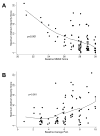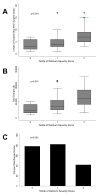Delirium After Spine Surgery in Older Adults: Incidence, Risk Factors, and Outcomes
- PMID: 27696373
- PMCID: PMC5407286
- DOI: 10.1111/jgs.14434
Delirium After Spine Surgery in Older Adults: Incidence, Risk Factors, and Outcomes
Abstract
Objectives: To characterize the incidence, risk factors, and consequences of delirium in older adults undergoing spine surgery.
Design: Prospective observational study.
Setting: Academic medical center.
Participants: Individuals aged 70 and older undergoing spine surgery (N = 89).
Measurements: Postoperative delirium and delirium severity were assessed using validated methods, including the Confusion Assessment Method (CAM), CAM for the Intensive Care Unit, Delirium Rating Scale-Revised-98, and chart review. Hospital-based outcomes were obtained from the medical record and hospital charges from data reported to the state.
Results: Thirty-six participants (40.5%) developed delirium after spine surgery, with 17 (47.2%) having purely hypoactive features. Independent predictors of delirium were lower baseline cognition, higher average baseline pain, more intravenous fluid administered, and baseline antidepressant medication. In adjusted models, the development of delirium was independently associated with higher quintile of length of stay (odds ratio (OR) = 3.66, 95% confidence interval (CI) = 1.48-9.04, P = .005), higher quintile of hospital charges (OR = 3.49, 95% CI = 1.35-9.00, P = .01), and lower odds of discharge to home (OR = 0.22, 95% CI = 0.07-0.69, P = .009). Severity of delirium was associated with higher quintile of hospital charges and lower odds of discharge to home.
Conclusion: Delirium is common after spine surgery in older adults, and baseline pain is an independent risk factor. Delirium is associated with longer stay, higher charges, and lower odds of discharge to home. Thus, prevention of delirium after spine surgery may be an important quality improvement goal.
Keywords: cost; delirium; outcomes; spine surgery.
© 2016, Copyright the Authors Journal compilation © 2016, The American Geriatrics Society.
Conflict of interest statement
[Table: see text]
Figures


References
-
- Murray A, Levkoff S, Wetle T, et al. Acute delirium and functional decline in the hospitalized elderly patient. J Gerontol. 1993;48:M181–M186. - PubMed
-
- Siddiqi N, House A, Holmes J. Occurrence and outcome of delirium in medical in-patients: a systematic literature review. Age Ageing. 2006;35(4):350–364. - PubMed
Publication types
MeSH terms
Grants and funding
LinkOut - more resources
Full Text Sources
Other Literature Sources
Medical

